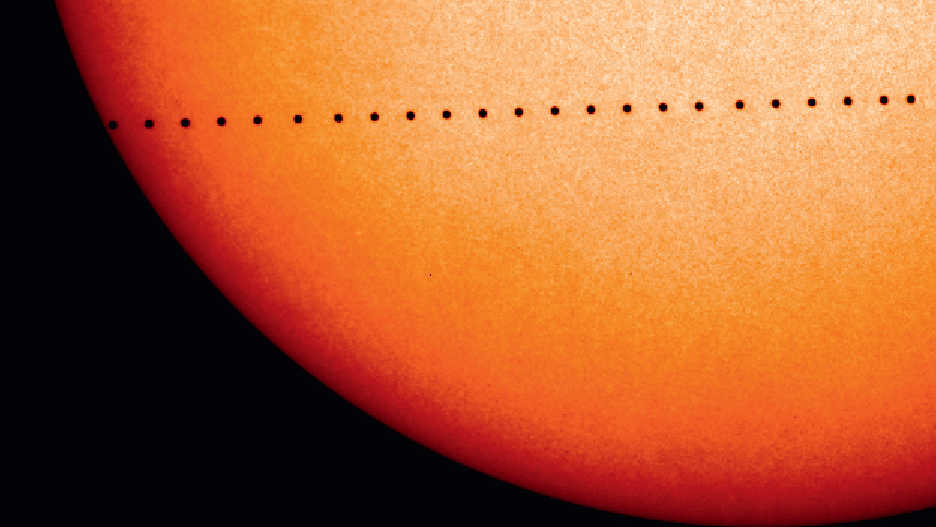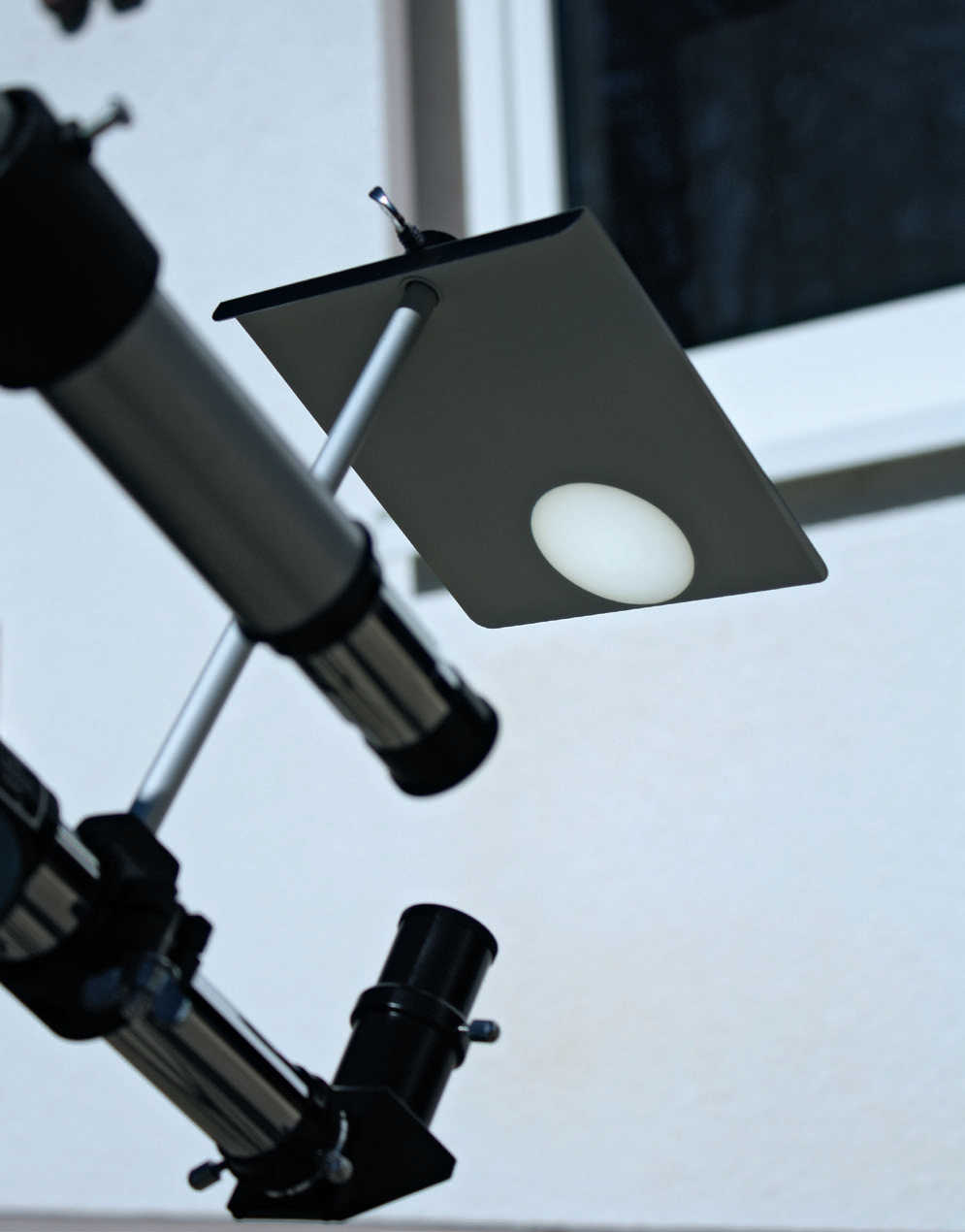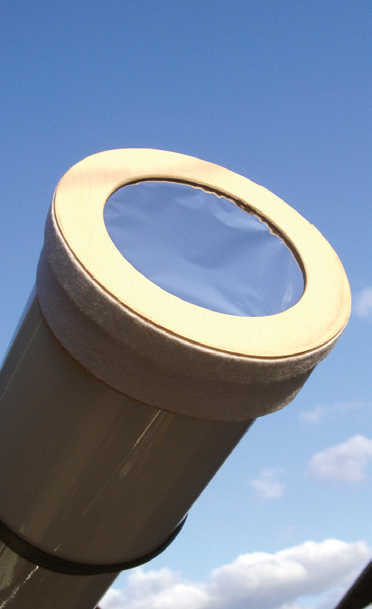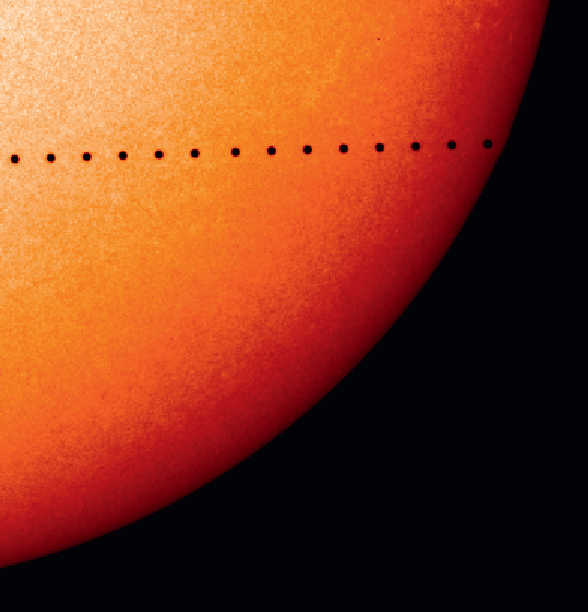The messenger of the gods passing in front of the Sun

Watch Mercury’s transit safely and easily on 9 May
A transit, i.e. Mercury passing across the face of the Sun, is a rare event. The observer can follow celestial mechanics live, as the planet passes in front of the Sun. The timing of the transit can be estimated exactly to the second, and Mercury will appear as a small black dot. But without the right equipment, such a transit cannot be observed safely. This is because, despite the Sun’s distance of around 150 million kilometres from Earth, large amounts of radiation of different wavelengths still reach the Earth's surface. An enormous amount of heat is created in the focal point of a telescope or binoculars, and our eyes must be protected from this.
The Sun projected
 A solar projection screen attached to the focuser is a safe method of observing a Mercury transit. Heiko Mehring
A solar projection screen attached to the focuser is a safe method of observing a Mercury transit. Heiko MehringThe safest way to observe the Sun is the so-called solar projection method. This involves a screen such as a light-coloured cardboard box held or fixed in place behind the optics, onto which an unfiltered image of the Sun is projected - very much like a slide projector. This allows several observers to view the image of the Sun at the same time. However, this method is only suitable for lens telescopes.
With solar projection, care should be taken not to use eyepieces with plastic lenses or plastic housings. These can be destroyed by the heat generated near the focal point. Zenith mirrors and zenith prisms can also be affected. Simple Huygens eyepieces are best suited for this task.
However, this type of eyepiece is generally no longer available to buy, so it’s worthwhile taking a look at the second-hand markets on some of the large astronomy forums (cf. surf tips).
 An attached solar filter also ensures safe solar observation. Lambert Spix
An attached solar filter also ensures safe solar observation. Lambert SpixA simple refractor with, for example, 60mm aperture is all you need for observing a Mercury transit. Use the telescope's shadow to help you to aim it at the Sun, so that the image of the Sun falls onto the bright projection surface. Because Mercury is relatively small, you should aim for the Sun to have a diameter of around 10cm. If the image is not bright enough, use a cardboard box to create some shade. Also make sure that the finderscope is covered. If you don't want to build a projection screen yourself, you can buy one ready-made.
The Solarscope is an inexpensive alternative to a telescope or binoculars. The Solarscope combines the optical element and projection screen in a sturdy cardboard box, which is quick to assemble and very easy to use.
The filtered Sun
 On 9 May, the time has come: Mercury appears as a small black dot during its transit as it roams across the face of the Sun. ESA/NASA/SOHO
On 9 May, the time has come: Mercury appears as a small black dot during its transit as it roams across the face of the Sun. ESA/NASA/SOHOAnother simple method of observing the Sun is to fix a solar filter IN FRONT OF the lenses of your binoculars or telescope. The intensity of the sunlight is reduced to such an extent that it is harmless to the eye. The Astrosolar solar filter is an example of such a safe solar filter. The efficiency of the filter is expressed in terms of its neutral density (ND). A value of ND 5 is suitable for visual observation and attenuates sunlight by a factor of 100,000. Simple space blanket material is not suitable, as it allows radiation that is harmful to the eye to pass through.
Solar filter film is also available in individual sheets, for example in A4 size. Together with a filter frame and little effort, you can build your own filter for your binoculars or telescope. You’ll find a rage of instructions on how to do this on the internet simply by searching for “solar filter film”. You need to be particularly careful that the frame is firmly attached and could not be knocked off, e.g. by a strong gust of wind. If you’re using a telescope, the finder should also be protected by a filter, because it is easy to accidentally look through it.
Practical tip
Safety first
• Beware! When observing the Sun, never look through binoculars or a telescope that have not been suitably protected with a solar filter. This would otherwise lead to immediate and serious damage to the eyes, even blindness. Also, binoculars or telescopes used for observing the Sun should never be left unattended, especially near children.
• Do not use eyepiece solar filters that are inserted in the telescope and screwed into the eyepiece. Since they are close to the focal point, they can become very hot and possibly burst. Then the sunlight would enter your eyes unhindered and damage them. Often these filters are labelled "Sun". If you’re unsure, do not use such filters at all.
Author: Lambert Spix / Licence: Oculum Verlag GmbH
